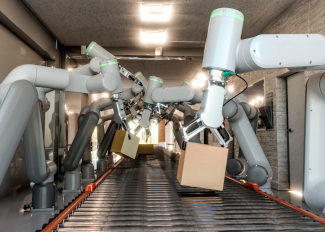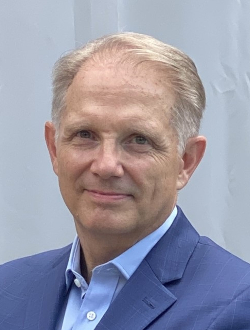The Robots are Coming
SERIES: Happy New TECH

Robotics applications in the laundry sector are increasing as Artificial Intelligence and robotic technology improves. We asked two experts from Jensen, which has been a leader in the move to robotics, to give us insight into where this side of the industry is headed.

Mads Andresen
Founder of Inwatec, which became part of the Jensen-Group in 2017. Since October 2023, he has held the position of Chief Innovation Officer at Jensen-Group.
“In the last 16 years, I’ve had the opportunity to work on some truly exciting innovations within laundry robotics and automation,” he said.

Anders Hansen
VP of Sales and Service Operations for Jensen USA, Inc. and the head of a newly created product team focused on automation.
“I first started with Jensen in Europe back in 1985 and have been with Jensen USA since 1993. It is exciting to lead Jensen’s automation revolution for the US market after many years of experience dealing with large automated systems, particularly garment systems,” he said.
How long has robotics been part of the industrial side of textile care? What earlier iterations of the technology have there been?
Mads Andresen: Robotics have been slowly making their way into the textile care industry over the past 20 years, but it’s really in the last 5 to 10 years that we’ve seen significant advancements and adoption.
Since early on, our innovations focused on improving the most dirty and heavy workplaces in the laundries. Robotics and AI have been introduced by Inwatec to take on separating, identifying and sorting articles on the soiled side. As robotics have evolved, so have the capabilities—now we see more complex, integrated systems that can, among others, handle robotic reliable towel feeding. While feeding systems have been around for a while, the AI revolution is allowing consistency and quality.
Anders Hansen: We have come a long way from the original sorting system that only processed garments by RFID. Our existing system is capable of handling almost all flatwork, terry and garment items, evidenced by the fact that there are laundries where Inwatec sorts nearly 99% of their incoming laundry.
There were some hardware changes over the years, like the alteration of the system to process flatwork linen, however many of the changes are not visibly apparent since they are related to software and machine learning. The system is proven to work exceptionally well, and it is exciting to move out of the prototyping stage and into a market adoptation stage.
Why is robotics a good fit for this industry? How does a plant benefit (beyond just labor savings)?
Mads Andresen: Robotics offer a significant advantage to the laundry industry because they provide a combination of precision, consistency, and scalability that is difficult for human workers to achieve. Beyond labor savings, robotics improves the sustainability of a laundry. From a soiled sort perspective, it offers greater consistency in handling of delicate fabrics, and we see the sorting accuracy is higher than the average operator. Higher sorting accuracy means less rewash, improved textile care, prolonging the linen’s lifespan while reducing chemical and water consumption in rewash. Additionally, the advantage of foreign object detection reduces potential linen or machine damage from dangerous objects and adds the advantage of improving workplace safety.
Anders Hansen: Another exciting potential behind soiled sorting is the ability for advanced production planning. With soiled sorting, laundries have a much clearer picture of production since they have scanned every item during sorting. We have helped laundries use this information to more efficiently plan production. For example, a laundry could use this to more accurately plan how clean side garment storage space is allocated. Robotics helps optimize space by making production lines more efficient, which can ultimately increase capacity and reduce operational costs.
What is Jensen doing in the line of robotic equipment? Describe the pieces you have brought to market, and those you hope to bring out in 2025.
Mads Andresen: At Jensen-Group, we’re continually innovating and pushing the boundaries of what robotics can do for the laundry industry. We’ve developed a number of robotic solutions already, such as our robotic sorting systems, which automate labor-intensive tasks like inspecting and sorting garments or linen. These solutions use computer vision systems and machine learning to ensure the highest levels of identification accuracy. Looking ahead to 2025, we’re focusing on expanding our robotic solutions for even higher throughputs on the soiled side and securing our new applications like the new BLIZZ towel feeding robot.
Is there hesitation on the part of plant owners about moving in the direction of robotics, and how do you overcome that reluctance?
Anders Hansen: There’s always some hesitation when it comes to adopting new technologies. One of the main concerns we hear about is the potential complexity of integrating robotics into existing operations. Helping customers understand this technology is the reason we decided to create our Automation Team. We offer extensive support, from consultation to installation and ongoing service. We also ensure that our systems are designed to integrate seamlessly with current workflows, and we emphasize the long-term return on investment, especially in terms of productivity gains and reduced operating costs. Showing success stories from our over 150 installed systems worldwide helps ease concerns and build trust in the technology.
Mads Andresen: We also see a lot of laundry owners concerned about maintenance. Some of them already have challenges finding good service engineers, and the idea of servicing state-of-the-art technology seems daunting. They are surprised to learn that maintenance for all the hardware is exceedingly simple, and it can be performed by a very basic engineer. Daily maintenance is typically just cleaning lint and oiling the occasional bearing or roller. The construction design is very modular, for example all Inwatec solutions use the same motor, meaning you only need a few spare parts on hand to keep your machine in operation. In the extremely rare instance requiring software troubleshooting, Jensen or Inwatec engineers can remote access the systems with local permission.
Share some success stories about robotic installations Jensen has done. How did they improve the plant operation, what has been the positive impact?
Mads Andresen: We’ve had great success stories, particularly with some large-scale industrial laundries that have implemented our robotic sorting systems. Most clients reduce their labor requirements while simultaneously increasing throughput and quality. The robots not only improve speed and efficiency but also reduce the risk of injury and fatigue among workers by taking over the most physically demanding tasks.
Anders Hansen: The US market has been a bit slower than the European market to adopt the technology, however we have a handful of customers like Clean Uniforms and More and Rent the Runway who have utilized the solution. We also have two big new projects nearing completion and about a dozen more in the pipeline, so stay tuned because we will see a lot more soiled sorting to come.
Thinking outside the box, is there a place for robotics (even on a small scale) in the dry cleaning arena? Have you seen examples in your travels that you can share? Is this a technology that will move beyond the industrial laundry area and into small plants?
Mads Andresen: We have successful robotic soiled sorting installations in several theme park laundries around the world, and they dry clean their costumes, so the solution is modular enough to be in front of wet wash and dry cleaning systems. However, the product is designed for industrial laundries. For establishments that don’t have substantial volumes of set categories, like a small dry cleaner, they could face practical challenges relating to unique item identification.
Anders Hansen: At the moment there is a massive market of industrial laundries that would greatly benefit from soiled sorting, and this is our primary target. Thanks to the large production volumes of industrial laundries, they will receive the fastest ROI on robotic solutions. However, since robotics is the future, it is very possible that at some point in the future even the smallest dry-cleaning shop will use some form of robotics.
What do you think the industrial laundry will look like 10 years from now? How much of it will be automated with robotics and how much will still require personal interaction?
Mads Andresen: In 10 years, I envision a highly automated industrial laundry environment where robotics and automation play a dominant role. Routine tasks like sorting, folding, and packaging will be largely handled by robots, while human workers will focus on overseeing operations, handling exceptions, and ensuring quality control. I believe personal interaction will still be necessary for troubleshooting, decision-making, and maintaining customer relationships. However, the overall role of the human workforce will shift from manual labor to more technical and managerial tasks. Automation will allow for much faster turnaround times, improved sustainability, and lower energy consumption.
Anders Hansen: This year we created Jensen’s automation team to help our customers stay prepared for the future. The revolution is more than robotics though. Machine learning, the Internet of Things, big data, and AI will revolutionize our industry in ways we haven’t even considered. We anticipate this revolution will be further integrated into materials handling that can result in a more streamlined production and eventually create touchless laundries. We also believe that improved data utilization will be able to assist production managers in their decisions as well as support maintenance teams. The changes to the industry that we have seen so far are just the tip of the iceberg.
What makes you excited about the robotics revolution that is beginning to take hold? Why do you feel it is the future?
Mads Andresen: What excites me the most about the robotics revolution in the laundry industry is the transformative potential it has to fundamentally change how we think about operations, labor, and sustainability. We’re at the dawn of a new era, where robots can handle repetitive tasks more efficiently, reduce waste, and improve overall productivity. What makes robotics particularly exciting is the rapid pace of innovation in AI, machine learning, and sensor technologies, which allows for continuous improvement in robot performance. I believe robotics is the future because it allows companies to scale up without sacrificing quality or worker well-being. As more industries adopt robotics, we’ll see a shift towards smarter, and safer working environments.
Anders Hansen: It is exciting because we are leading a revolution in our industry. The solution can solve many pressing challenges related to production, and we have only positive feedback from existing customers. Also, interestingly with soiled sorting, the discussion is almost never about a robot taking someone’s job, and instead, it is a robot performing a task that is difficult to find operators willing to perform. There is a social need, an operational need, and a market need, and Jensen has a solution that is tested and proven to work. What’s not to be excited about!
Look for live examples of robotics in the Jensen booth and other booths at the Clean Show in August!






